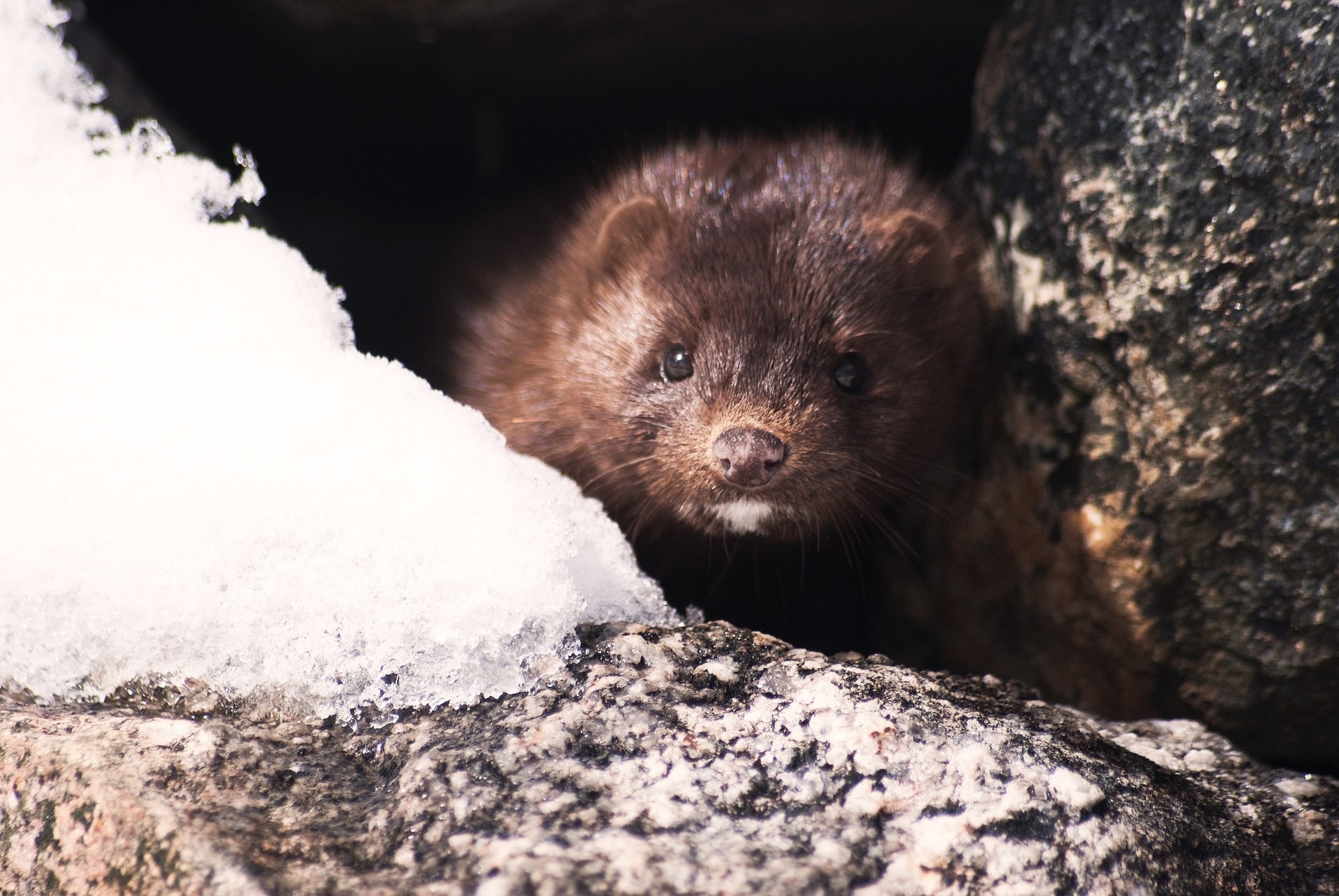In the current coronavirus pandemic, human-to-human transmission is the primary focus and is responsible for the rapid global spread, which is why countries around the world have turned to social contact restrictions for containment. However, in addition to the dominant transmission between humans, there are also some animal species that can become infected with the virus. This has already been demonstrated for dogs, cats [1], tigers [2], hamsters [3], fruit bats, ferrets [4], and macaques [5].
SARS-CoV-2 infections in mink
In late April 2020, as the first wave of SARS-CoV-2 infections swept through Europe, mink also became infected on farms in the Netherlands. The animals are kept for fur production. It is suspected that the animals had contracted the virus from an infected employee of the mink farms. The virus was able to spread rapidly between the caged animals. The infected animals presumably infected at least one other farm worker. [6] In addition, antibodies against SARS-CoV-2 were also found in wild cats that roamed the farms in search of food [6]. The event resulted in the culling of thousands of mink from the affected farms on June 6, 2020 (see article in Science). This was because even though the infection was asymptomatic in a large proportion of the animals, Dutch authorities feared that the minks could act as a reservoir for the virus, which would further fuel the pandemic. In addition to the mink farms in Holland, farms in Spain were also affected, where several thousand animals were also killed after the infections became known.

Fig.1: Mink are kept for fur production. Like humans the animals can be infected with SARS-CoV-2 (picture: Pixabay)
Cases of SARS-CoV-2 in Danish mink farms
The largest producer of mink furs in Europe is Denmark, with over 1000 mink farms (Statistics Denmark). According to the Danish Council for Food and Agriculture, furs and mink skins are the third largest Danish agricultural export products of animal origin, with an annual export value of approximately 1.1 billion euros. However, the COVID-19 pandemic has now reached Danish farms. Especially mink farms in the north of Jutland are affected. SARS-CoV-2 has been detected in more than 200 farms. As a first step, the Danish government then ordered the killing of all mink on the affected farms and on farms within a radius of 7.8 kilometers on October 1, 2020 (see ministry website).
But findings by researchers at the Danish Statens Serum Institut (SSI) in the genetic material of the virus from humans and mink, prompted the Danish government to take even more drastic steps. A press release on 5 November 2020 from the Danish Ministry of Environment and Food announces an order that all mink in Denmark be culled. In addition to killing the minks, restrictions were also imposed on the population in some municipalities in northern Jutland (Hjørring, Frederikshavn, Brønderslev, Jammerbugt, Vesthimmerland, Thisted and Læsø) to prevent the virus from spreading further in the country from there. The ministry justified this action on the one hand with the failed efforts to contain the infection in the individual affected farms. On the other hand, there was also the danger that the virus could acquire mutations in the course of its adaptation to the new host, which could prove to be less sensitive to a vaccine in the event of reinfection of humans (Fig. 2).
Fig. 2: Spillover Event and Reinfection
Mutated virus variant reason for precautionary measures
The reason for this suspicion and the resulting far-reaching precautionary measures is the discovery of mutations in the genome of the virus from mink and humans made by researchers at the Danish SSI. The Danish ministry reported in its press release that preliminary studies indicate that these mutations could affect the efficacy of current vaccine candidates against COVID-19. The prime minister of Denmark, Mette Frederiksen, told the Reuters news agency that health authorities have found lower sensitivity of a viral variant to antibodies from already infected individuals.
The spike protein and the vaccine
The SSI writes on its website that the SARS-CoV-2 variants found in minks can be divided into 5 different clusters based on their genomic sequence. In these clusters, variants with different mutations in the spike protein of the virus can be found. These mutations are of particular interest because both the human immune system and the vaccine candidates currently being tested recognize structures of the spike protein as immunogens. This means that these structures are relevant for the induction of an adaptive immune response. A mutation in this region could therefore have an impact on the efficacy of a vaccine. In viruses from cluster 5, four different mutations of the spike protein were found. These mutations affect the following amino acids of the spike protein: H69del/V70del, Y453F, I692V and M1229I. According to SSI, initial studies have now shown a reduced sensitivity of this virus variant to antibodies from COVID-19 patients. Information on all virus variants will be uploaded to the international GISAID database to allow scientists worldwide to access it, according to the institute.
Better safe than sorry
At present, published research data and other studies are lacking to support the Danish researchers' claims. In an article in STAT, some scientists express doubt that single mutations could be sufficient to render vaccine candidates completely ineffective. Also, there is currently no evidence that mutations acquired in minks would lead to higher pathogenicity in humans. However, the Danish government does not want to take any chances at this point and is following the motto "better safe than sorry." For Danish mink production, this means a ban from 2021.
As soon as the relevant gene sequences have been made available to the global research community by the Danish scientists, a data-based assessment of the risk posed by the new virus strain can be made. However, a mere look at the sequences will not be sufficient to conclusively assess the impact of the mutation on the behavior of the virus towards the immune system. This will require both in vitro analyses, such as binding analyses with the spike protein of the virus or serum neutralization test (SNT) studies, as well as in vivo experiments to understand the complex interactions of the mutant virus with the immune system.
Real-time monitoring of virus adaptions
The great attention with which the scientific community is currently following the development of the virus worldwide has meant that the spillover of the virus from humans to mink has been discovered very quickly and can be studied in real time on a genetic level. Even if these changes do not ultimately have any impact on the immune properties of the virus, this real-time view of virus adaptation at the genetic level is very exciting from a scientific point of view.
Text: Dr. Dana Thal for the German Research Platform for Zoonoses
Literature:
- Shi, J., et al., Susceptibility of ferrets, cats, dogs, and other domesticated animals to SARS-coronavirus 2. Science, 2020. 368(6494): p. 1016-1020.
- McAloose, D., et al., From People to Panthera: Natural SARS-CoV-2 Infection in Tigers and Lions at the Bronx Zoo. mBio, 2020. 11(5).
- Chan, J.F., et al., Simulation of the clinical and pathological manifestations of Coronavirus Disease 2019 (COVID-19) in golden Syrian hamster model: implications for disease pathogenesis and transmissibility. Clin Infect Dis, 2020.
- Schlottau, K., et al., SARS-CoV-2 in fruit bats, ferrets, pigs, and chickens: an experimental transmission study. The Lancet Microbe, 2020.
- Munster, V.J., et al., Respiratory disease in rhesus macaques inoculated with SARS-CoV-2. Nature, 2020. 585(7824): p. 268-272.
- Oreshkova, N., et al., SARS-CoV-2 infection in farmed minks, the Netherlands, April and May 2020. Euro Surveill, 2020. 25(23).



